unit1grammar教学设计 (1)
- 格式:docx
- 大小:14.12 KB
- 文档页数:2
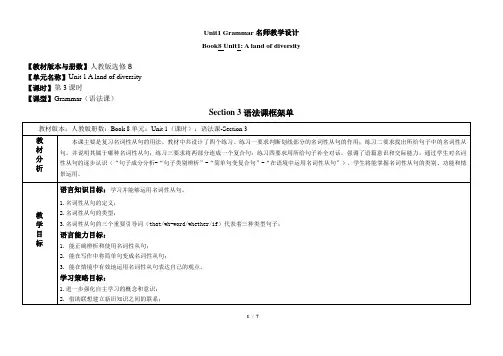
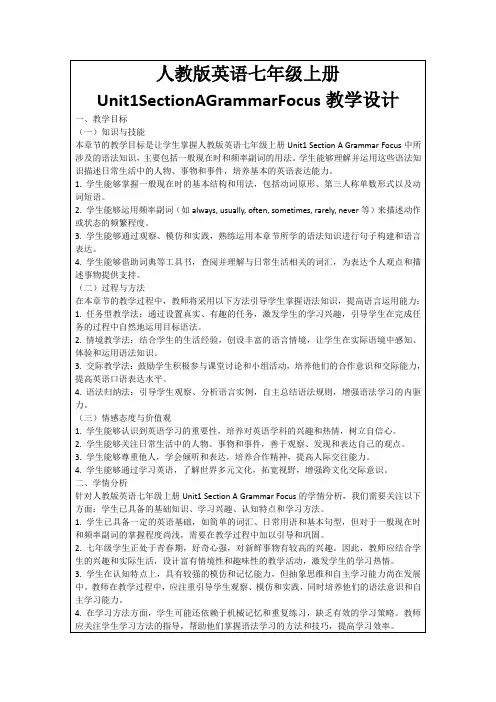
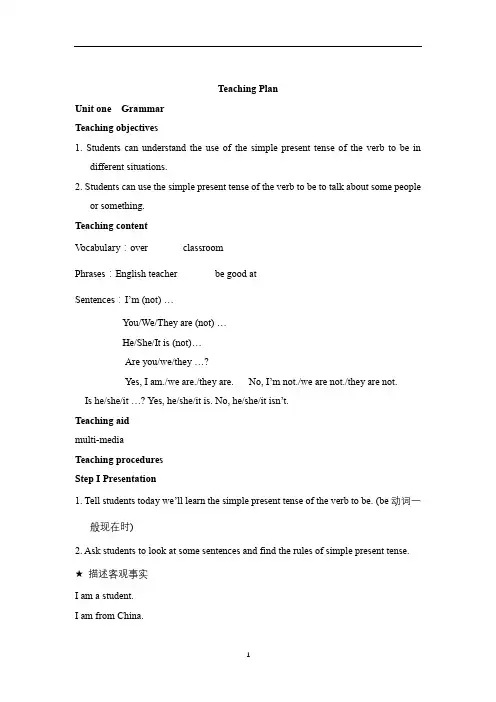
Teaching PlanUnit one GrammarTeaching objectives1. Students can understand the use of the simple present tense of the verb to be indifferent situations.2. Students can use the simple present tense of the verb to be to talk about some peopleor something.Teaching contentV ocabulary:over classroomPhrases:English teacher be good atSentences:I’m (not) …You/We/They are (not) …He/She/It is (not)…Are you/we/they …?Yes, I am./we are./they are. No, I’m not./we are not./they are not.Is he/she/it …? Yes, he/she/it is. No, he/she/it isn’t.Teaching aidmulti-mediaTeaching proceduresStep I Presentation1. Tell students today we’ll learn the simple present tense of the verb to be. (be动词一般现在时)2. Ask students to look at some sentences and find the rules of simple present tense.★描述客观事实I am a student.I am from China.我来自中国。
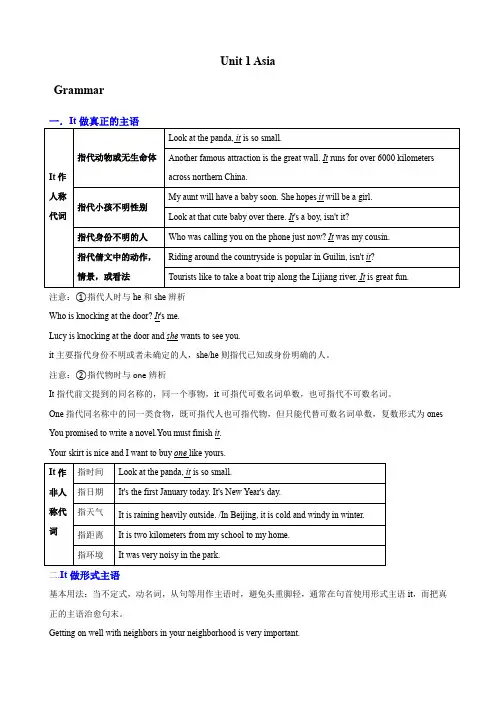
Unit 1 AsiaGrammar注意:①指代人时与he 和she 辨析Lucy is knocking at the door and she wants to see you.it 主要指代身份不明或者未确定的人,she/he 则指代已知或身份明确的人。
注意:②指代物时与one 辨析It 指代前文提到的同名称的,同一个事物,it 可指代可数名词单数,也可指代不可数名词。
One 指代同名称中的同一类食物,既可指代人也可指代物,但只能代替可数名词单数,复数形式为ones You promised to write a novel.You must finish it .Your skirt is nice and I want to buy one like yours.二.It 做形式主语基本用法:当不定式,动名词,从句等用作主语时,避免头重脚轻,通常在句首使用形式主语it ,而把真正的主语治愈句末。
Getting on well with neighbors in your neighborhood is very important.It's important to get on well with neighbors in your neighborhood.1.It's +adj+( for/of) sb. to do sth.①It be adj. for sb. to do sth.adj.通常为描述事件的形容词:easy,difficult,hard,necessary,possible,important,polite,dangerous,legal等①It be adj. of sb. to do sth.adj.通常为描述人的形容词:kind,nice,rude,cruel,thoughtful,careful,clever,foolish,stupid,wise,crazy等2.It is adj./n. to do sth.&It is adj./n. that从句It's a waste of time to play puter games all day.It's amazing that there are so many rocks in unusual shapes in the cave.It is a pity that she failed in the exam again.3.It is of +n.(抽象名词)to do sthIt is useful to master more words to improve your English.=It is of use to master more words to improve your English.It’s important to get on well with neighbors in your neighborhood.=It’s of importance to get on well with neighbors in your neighborhood.4.It is time for sth=It is time to do sth 该做某事了。
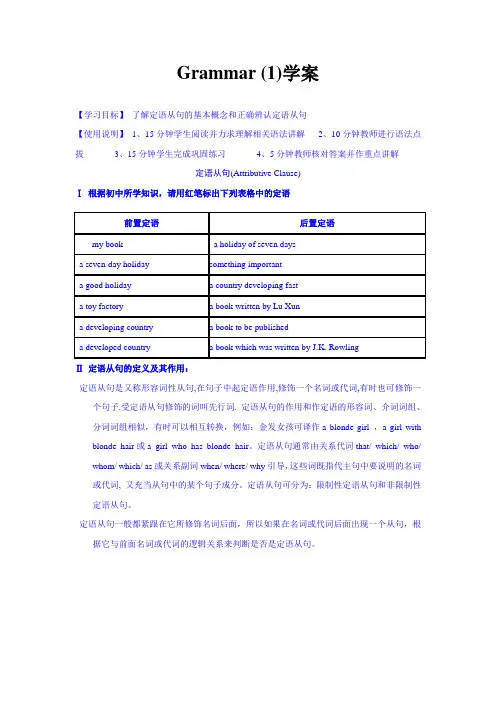
Grammar (1)学案【学习目标】了解定语从句的基本概念和正确辨认定语从句【使用说明】1、15分钟学生阅读并力求理解相关语法讲解2、10分钟教师进行语法点拔3、15分钟学生完成巩固练习4、5分钟教师核对答案并作重点讲解定语从句(Attributive Clause)Ⅰ根据初中所学知识,请用红笔标出下列表格中的定语Ⅱ定语从句的定义及其作用:定语从句是又称形容词性从句,在句子中起定语作用,修饰一个名词或代词,有时也可修饰一个句子.受定语从句修饰的词叫先行词. 定语从句的作用和作定语的形容词、介词词组、分词词组相似,有时可以相互转换,例如:金发女孩可译作a blonde girl ,a girl with blonde hair或a girl who has blonde hair。
定语从句通常由关系代词that/ which/ who/ whom/ which/ as或关系副词when/ where/ why引导,这些词既指代主句中要说明的名词或代词, 又充当从句中的某个句子成分。
定语从句可分为:限制性定语从句和非限制性定语从句。
定语从句一般都紧跟在它所修饰名词后面,所以如果在名词或代词后面出现一个从句,根据它与前面名词或代词的逻辑关系来判断是否是定语从句。
找出下列句中的定语从句;分析定语从句三要素1. You are the right man whom we are looking for.2. I’ve spent all the money that was given by my parents.3. I will never forget the day when I joined the party.4. This is the factory where the machines are made.Ⅳ 关系代词的用法:Ⅴ 课堂练习 12关系词 3关系词在从句中充当成分relative pron. (as sub. ,obj. ,pred.)(that 指人或物 / which 指物 / who(m) 指人/ whose)relative adv. (as adverbial)(when / where / why)Ⅲ 定语从句的必备三要素1 找出下列各句中的定语从句,并分析其先行词:1 The fan that you want is on the desk.2 The woman you saw in the park is our geography teacher.3 Here is the girl whose brother works in this shop.4 That’s the child whose drawing we were looking at just now.5 This is the boy whose sister is a famous singer.2 把下列每对句子合并成含有定语从句的主从复合句1. The man is in the next room. He brought our textbooks here yesterday.2. The magazine is mine. He has taken it away.3. The students will not pass the exam. They don’t study hard.4. The letter is from my sister. I received it yesterday.5. The play was wonderful. We saw it last night.6. The train was late. It was going to Nanning.。
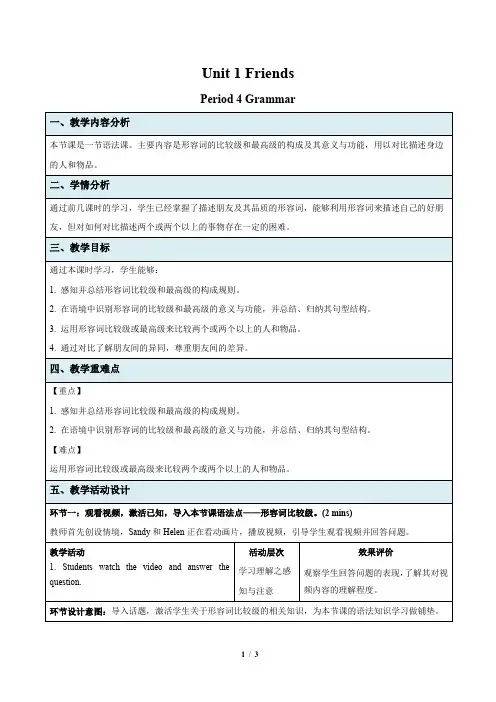
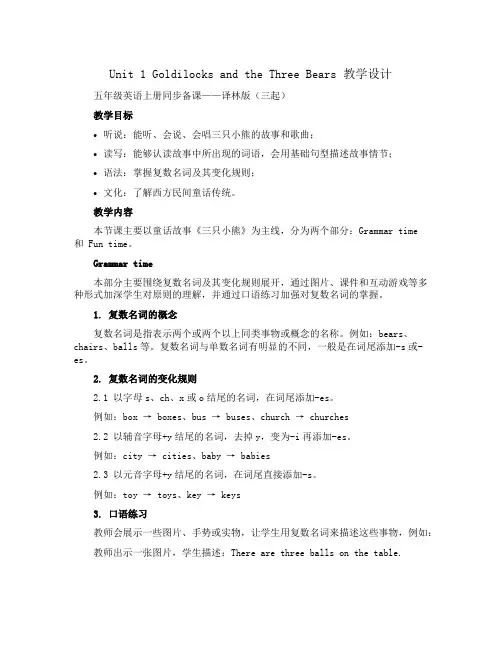
Unit 1 Goldilocks and the Three Bears 教学设计五年级英语上册同步备课——译林版(三起)教学目标•听说:能听、会说、会唱三只小熊的故事和歌曲;•读写:能够认读故事中所出现的词语,会用基础句型描述故事情节;•语法:掌握复数名词及其变化规则;•文化:了解西方民间童话传统。
教学内容本节课主要以童话故事《三只小熊》为主线,分为两个部分:Grammar time和 Fun time。
Grammar time本部分主要围绕复数名词及其变化规则展开,通过图片、课件和互动游戏等多种形式加深学生对原则的理解,并通过口语练习加强对复数名词的掌握。
1. 复数名词的概念复数名词是指表示两个或两个以上同类事物或概念的名称。
例如:bears、chairs、balls等。
复数名词与单数名词有明显的不同,一般是在词尾添加-s或-es。
2. 复数名词的变化规则2.1 以字母s、ch、x或o结尾的名词,在词尾添加-es。
例如:box → boxes、bus → buses、church → churches2.2 以辅音字母+y结尾的名词,去掉y,变为-i再添加-es。
例如:city → cities、baby → babies2.3 以元音字母+y结尾的名词,在词尾直接添加-s。
例如:toy → toys、key → keys3. 口语练习教师会展示一些图片、手势或实物,让学生用复数名词来描述这些事物,例如:教师出示一张图片,学生描述:There are three balls on the table.4. 语法练习教师准备若干复数名词,让学生判断其变化规则,并进行口语问答和填空练习。
例如:•apple → ___________•desk → ___________•fish → ___________•bird → ___________Fun timeFun time 是本节课的乐趣时光,通过较为有趣的小游戏和音乐活动来巩固学生对于故事情节和语言知识的记忆,并培养学生对于阅读和语言学习的趣味和兴趣。
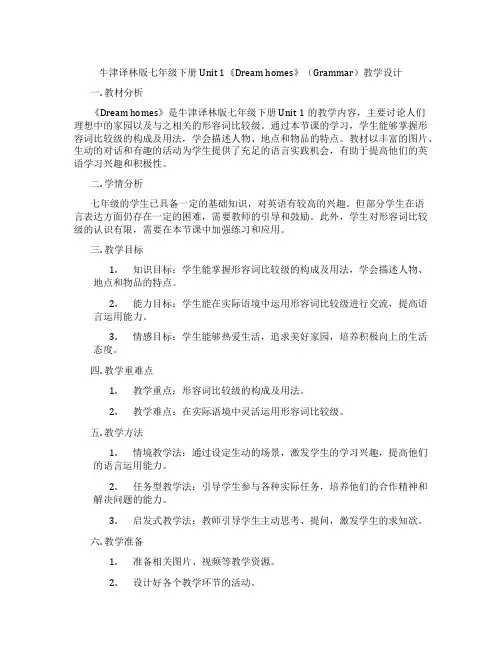
牛津译林版七年级下册Unit 1《Dream homes》(Grammar)教学设计一. 教材分析《Dream homes》是牛津译林版七年级下册Unit 1的教学内容,主要讨论人们理想中的家园以及与之相关的形容词比较级。
通过本节课的学习,学生能够掌握形容词比较级的构成及用法,学会描述人物、地点和物品的特点。
教材以丰富的图片、生动的对话和有趣的活动为学生提供了充足的语言实践机会,有助于提高他们的英语学习兴趣和积极性。
二. 学情分析七年级的学生已具备一定的基础知识,对英语有较高的兴趣。
但部分学生在语言表达方面仍存在一定的困难,需要教师的引导和鼓励。
此外,学生对形容词比较级的认识有限,需要在本节课中加强练习和应用。
三. 教学目标1.知识目标:学生能掌握形容词比较级的构成及用法,学会描述人物、地点和物品的特点。
2.能力目标:学生能在实际语境中运用形容词比较级进行交流,提高语言运用能力。
3.情感目标:学生能够热爱生活,追求美好家园,培养积极向上的生活态度。
四. 教学重难点1.教学重点:形容词比较级的构成及用法。
2.教学难点:在实际语境中灵活运用形容词比较级。
五. 教学方法1.情境教学法:通过设定生动的场景,激发学生的学习兴趣,提高他们的语言运用能力。
2.任务型教学法:引导学生参与各种实际任务,培养他们的合作精神和解决问题的能力。
3.启发式教学法:教师引导学生主动思考、提问,激发学生的求知欲。
六. 教学准备1.准备相关图片、视频等教学资源。
2.设计好各个教学环节的活动。
3.准备黑板、粉笔等教学工具。
七. 教学过程1.导入(5分钟)利用图片或视频展示不同的家园场景,引导学生谈论他们喜欢的家园特点。
教师提问:“What kind of home do you like?”,学生回答:“I like a home with a big garden.” 以此引出本节课的主题。
2.呈现(10分钟)教师展示形容词比较级的结构:“adjective + er”,并用例词进行解释。
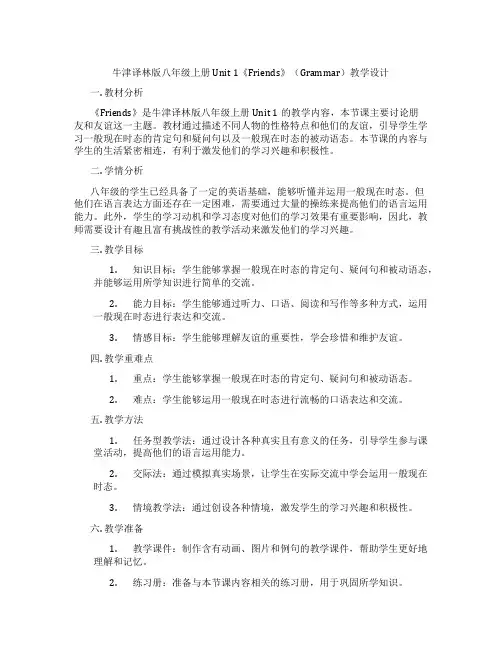
牛津译林版八年级上册Unit 1《Friends》(Grammar)教学设计一. 教材分析《Friends》是牛津译林版八年级上册Unit 1的教学内容,本节课主要讨论朋友和友谊这一主题。
教材通过描述不同人物的性格特点和他们的友谊,引导学生学习一般现在时态的肯定句和疑问句以及一般现在时态的被动语态。
本节课的内容与学生的生活紧密相连,有利于激发他们的学习兴趣和积极性。
二. 学情分析八年级的学生已经具备了一定的英语基础,能够听懂并运用一般现在时态。
但他们在语言表达方面还存在一定困难,需要通过大量的操练来提高他们的语言运用能力。
此外,学生的学习动机和学习态度对他们的学习效果有重要影响,因此,教师需要设计有趣且富有挑战性的教学活动来激发他们的学习兴趣。
三. 教学目标1.知识目标:学生能够掌握一般现在时态的肯定句、疑问句和被动语态,并能够运用所学知识进行简单的交流。
2.能力目标:学生能够通过听力、口语、阅读和写作等多种方式,运用一般现在时态进行表达和交流。
3.情感目标:学生能够理解友谊的重要性,学会珍惜和维护友谊。
四. 教学重难点1.重点:学生能够掌握一般现在时态的肯定句、疑问句和被动语态。
2.难点:学生能够运用一般现在时态进行流畅的口语表达和交流。
五. 教学方法1.任务型教学法:通过设计各种真实且有意义的任务,引导学生参与课堂活动,提高他们的语言运用能力。
2.交际法:通过模拟真实场景,让学生在实际交流中学会运用一般现在时态。
3.情境教学法:通过创设各种情境,激发学生的学习兴趣和积极性。
六. 教学准备1.教学课件:制作含有动画、图片和例句的教学课件,帮助学生更好地理解和记忆。
2.练习册:准备与本节课内容相关的练习册,用于巩固所学知识。
3.听力材料:准备与本节课主题相关的听力材料,帮助学生提高听力技能。
七. 教学过程1.导入(5分钟)通过向学生提问“你的朋友是什么样的人?”等问题,引导学生谈论朋友和友谊,激发他们的学习兴趣。
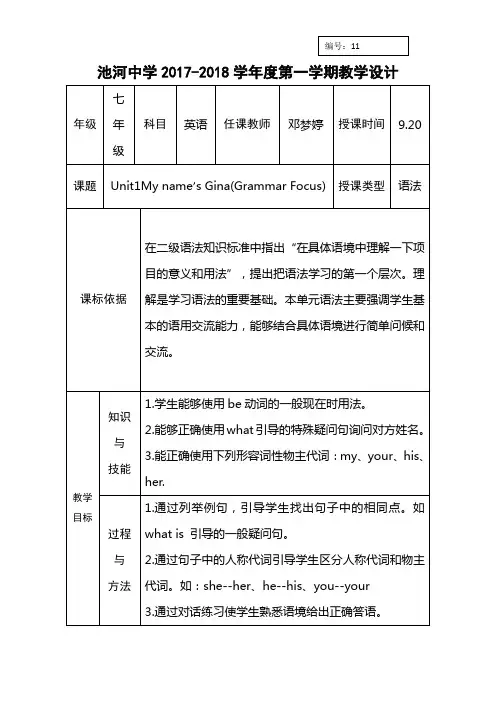
池河中学2017-2018学年度第一学期教学设计年级七年级科目英语任课教师邓梦婷授课时间9.20课题Unit1My name’s Gina(Grammar Focus) 授课类型语法课标依据在二级语法知识标准中指出“在具体语境中理解一下项目的意义和用法”,提出把语法学习的第一个层次。
理解是学习语法的重要基础。
本单元语法主要强调学生基本的语用交流能力,能够结合具体语境进行简单问候和交流。
教学目标知识与技能1.学生能够使用be动词的一般现在时用法。
2.能够正确使用what引导的特殊疑问句询问对方姓名。
3.能正确使用下列形容词性物主代词:my、your、his、her.过程与方法1.通过列举例句,引导学生找出句子中的相同点。
如what is 引导的一般疑问句。
2.通过句子中的人称代词引导学生区分人称代词和物主代词。
如:she--her、he--his、you--your3.通过对话练习使学生熟悉语境给出正确答语。
编号:11情感态度与价值观1.裴昂学生敢于开口、积极参与的学习态度。
2.体会英语角机的乐趣、快乐。
3.开朗大方,乐观的生活态度。
教学重点难点教学重点1.what引导的一般疑问句。
2.学习运用be动词构成一般疑问句。
3.学会一般疑问句的肯定、否定回答。
教学难点1.引导学生掌握基本人称代词、物主代词,理解意思,能够区分运用。
2.尝试用一般疑问词组织简单的一般疑问句。
3.理解一般陈述句转换为疑问句的方法。
4.理解单词缩写形式的意义并掌握发音。
教学过程设计师生活动设计意图Lead-in: Greeting with students by using sentences on section A. Leadstudents come to the English class.T:Hello, boys and girls,how are you?S: I’m fine thanks. and you?Teaching Procedures:Step1: Ask students names by using the sentences: What’s yourname?/What’s his/her name?T: What’s your name?S1: my name’s ....S2: I’m ...T: what’s his/her name?S: his/ her name’s.Step2: list sentences on the blackboard and have students find differences.T: please look at these two sentences .can you tell me whatdifferences and commons among these sentences.S: They are questions./ They all have”what’s”/first sentence is“your”,the second one is his/her.T: Yes,they are all questions, and please pay attention to the pronunciation [ts:], [z](讲解人称代词在不同句子中的意思及用法)Step3: lead students read key sentences in grammar focus,especiallydistinguish different questions and answers. Students make conversationby using these sentences.Step4. lead students finish first sentence on 3a, analyze tips withstudents about how to put the word in order. then have students finish1.通过对话引导学生复习本单元关于询问名字的句子,引导学生正确运用目标语言。
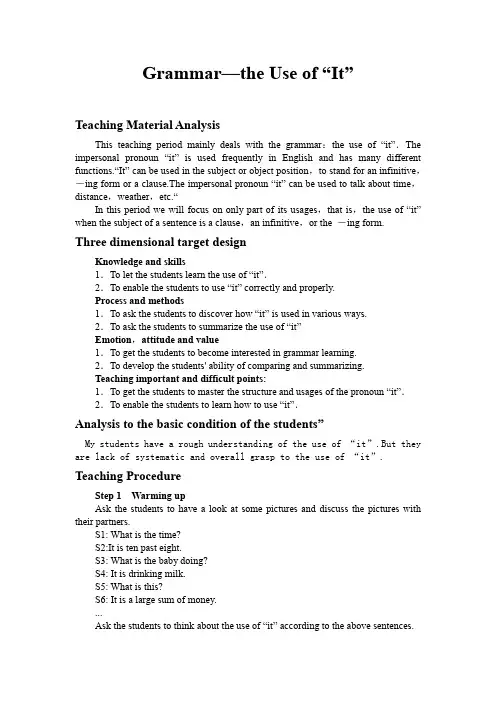
Grammar—the Use of “It”Teaching Material AnalysisThis teaching period mainly deals with the grammar:the use of “it”.The impersonal pronoun “it” is used frequently in English and has many different functions.“It” can be used in the subject or object position,to stand for an infinitive,-ing form or a clause.The impersonal pronoun “it” can be used to talk about time,distance,weather,etc.“In this period we will focus on only part of its usages,that is,the use of “it” when the subject of a sentence is a clause,an infinitive,or the -ing form.Three dimensional target designKnowledge and skills1.To let the students learn the use of “it”.2.To enable the students to use “it” correctly and properly.Process and methods1.To ask the students to discover how “it” is used in various ways.2.To ask the students to summarize the use of “it”Emotion,attitude and value1.To get the students to become interested in grammar learning.2.To develop the students' ability of comparing and summarizing.Teaching important and difficult points:1.To get the students to master the structure and usages of the pronoun “it”.2.To enable the students to learn how to use “it”.Analysis to the basic condition of the students”My students have a rough understanding of the use of “it”.But they are lack of systematic and overall grasp to the use of “it”.Teaching ProcedureStep 1Warming upAsk the students to have a look at some pictures and discuss the pictures with their partners.S1: What is the time?S2:It is ten past eight.S3: What is the baby doing?S4: It is drinking milk.S5: What is this?S6: It is a large sum of money....Ask the students to think about the use of “it” according to the above sentences.Step 2Grammar learningAsk the students to study the following sentences and try to summarize the structure and usages of“it”.1.The personal pronoun “it” and the impersonal pronoun “it”.(1) -What do you think of the cartoon?-It’s interesting/funny.(2) It is said that he is the most handsome boy,but is it true?(3) It rains heavily.(4). It is 20 kilometers from Granddad'shouse to James’.(5). It is November 11, 2005.(6). It is 9 o’clock at night.(7).It‘s quiet here.2.“It” is used in the subject position.1).It's no use cheating in the test .2).It`s reported that Wang Lihong got married.3).It is difficult to quit smoking.It is/was+_n._或p.p.___或_adj.__+ _v-ing_____________.It is/was+_n._或_p.p__或_adj.__+ ___that-clause__________.It is/was+_n._或_p.p__或_adj.__+ to do sth(1) It is +名词+that-从句/ to doIt is___a shame_____that可耻的是......It is__a pity________that 可惜的是......It is ____an honor______that光荣的是......(2) It is +adj. +that-从句/to doIt is _natural______ that …......是自然的It is___clear____ that ......是清楚的It is__necessary__that ......是有必要的(3) It is +p.p. +that-从句It is __reported__that …据报道......It is ___said___that... 据说......It is __suggested_____ that 据建议......Step 3 Summing upTry to help the students draw the following conclusions.1.“It” is a very useful word and can be used in many ways.2.The personal pronoun “it” can substitute something that is mentioned before.In some certain situations,“it” can stand for an u nidentified person or a baby.3.The impersonal pronoun “it” can be used to talk about time,distance,weather,etc.4.“It” can act as a subject,while the real subject or object can be put backwards in the form of an infinitive,-ing form or a clause.Step 4 Grammar practiceAsk students to do the following excises:1.Rewrite the sentences using “it” structures given.(1)Giving up smoking is difficult.(It is...)(2)Most people believe smoking causes cancer.(It is believed...)(3)That you can’t go with us is a pity. (It is a pity...)(4)Don't quit on a stressful day.(It's no use...)Suggested answers:(1)It is difficult to give up smoking.(2)It is believed that smoking causes cancer.(3) It is a pity that you can’t go with us.(4)It is no use trying to quit on a stressful day.Teaching ReflectionIn the context, the students had a more vivid and deep understanding to the use of “it”. So we should always bear in mind that we must get students learn language-related knowledge in context.We should not separate it from the context.。
Unit 1 The mass mediaGrammar and usage (Ⅰ)Past perfect tense◆内容分析:本板块的语篇围绕单元话题“大众传媒”,介绍了美国新闻工作者、出版家约瑟夫•普利策的生平事迹。
首先要求学生阅读语篇,探究过去完成时的概念,并归纳过去完成时使用的一般规则;其次,引导学生在句子和语篇两个层面循序浙进地练习并巩固所学,深化理解过去完成时的含义;最后要求学生叙述中国新闻工作者、出版家邹韬奋的生平,在具体语境中正确使用过去完成时。
◆教学目标:By the end of this section, students will be able to:1.understand the usage of the past perfect tense;2.identity the verb form of the past perfect tense;e the right forms of the past perfect tense to correct the mistakes and complete an article;4.apply the past perfect tense in new contexts.◆教学重难点:1.To apply the rules correctly and properly;2.Develop the thinking ability by analyzing and summarizing the grammar rules.◆教学过程:Step 1 Lead in1. T asks the Ss to read part A on page 6 and complete the True or False exercise.1) He regularly visited the library and studied English and Law-by then he had learnt very little French. ( F )2) By the age of 25, he had become a teacher. ( F )3) He used the same business strategy he had employed at the St Louis Post-Dispatch and sales of the newspaper mounted up until it was the bestselling newspaper in the country. ( T )2. T asks the Ss the following questions1) When and where was Joseph Pulitzer born?Suggested answer: Joseph Pulitzer was born on April 10, 1847, in Hungary.2) When did Joseph Pulitzer found the newspaper the St Louis Post-Dispatch? Suggested answer: In 1878.3) In 1892, what did he offer Columbia University money to start?Suggested answer: He offered Columbia University money to start a school of journalism.4) When were the first Pulitzer Prizes were awarded?Suggested answer: Six years after Joseph Pulitzer’s death.【设计意图:老师一开始通过分享Joseph Pulitzer的生活故事,设置对与错以及回答问题的练习让学生在具体的情境中提前感知本节课的语法知识。
Unit1 Grammar名师教案I. Teaching aims and learning objectivesBy the end of the lesson, students should be able to:1. use the conjunctions “and”, “but” , “or” and “so” to join ideas together.2. use “both… and”, “not only… but also”, “either… or” and “n either … nor” to connect the same part of the two sentences.II. Teaching contents1. New words and phrases: impatient, think twice (about sth.), do the dishes2. Structures: Both Kitty and Simon are energetic.Not only the students but also their teacher knows about the four people.Either Simon or David is ready to take on new challenges.Neither Millie nor her friends know about types of personality.III. Focus of the lesson and predicted area of difficulty1. Talk about something with the correct conjunctions;2. Use the verb form after “not only… but also”, “either… or” and “neither… nor” correctly.ⅣPreview(课前预习)活动一:爱观察:本单元我们主要学习连词and, but, or, so和both…and…, not only..but also…, either…or…, neither…or…,教材中Reading部分已学过的关于这些连词句子有哪些?尝试在课本中画出来,观察它们有什么特点?试着找找规律吧!活动二:仔细阅读教材Grammar部分,注意比较级both…and…, not only..but also…, either…or…, neither…or…的用法,观看视频讲解,尝试总结,我学到了什么?试着画出思维导图,拍照上传,与大家分享吧!活动三:爱创作:用学到的语法结构,再结合着本单元已学到的知识,尝试用这些连词编写一段对话或者写一首小诗,并将自己的成果上传分享!【备注:学生登录“优教·同步学习网”完成本课时预习任务,教师可通过备课端查看预习结果反馈,针对性进行课堂教学】Ⅴ.Teaching proceduresA Using and, but, or and soStep 1 Lead inFree talkT: Today, we’ll learn Grammar of Unit 1.We’ve met four outstanding persons. Do you remember them? (Show the pictures of the characters we’ve learned)S: They are Wu Wei, Su Ning, Liu Tao and Fang Yuan.T: Among them, I admire Wu Wei best because I wanted to be an artist when I was young.【设计意图:通过复习Reading中人物,导入新课,利用已有知识过渡至新板块的学习,使学生迅速进入学习状态。
Unit 1 Goldilocks and the Three bears 教学设计Grammar在本课中,语法重点是“第三人称单数现在时(Present Simple Tense)”。
语言目标学生要掌握第三人称单数现在时的基本用法和构成规律。
教学步骤1.通过介绍Goldilocks and the Three bears这个经典故事,引入第三人称单数现在时的概念。
2.和学生们一起复习第一人称单数现在时和第二人称单数现在时的构成规律和用法。
3.解释第三人称单数现在时的构成规律,即在动词后加-s或-es,并提供一些例子。
4.教授这种时态的用法,并提供一些例子供学生们练习。
课堂练习1.练习构成规律:让学生们根据规律填空。
2.练习用法:提供一些描写人物活动的图片,让学生们根据图片句子填空,使用第三人称单数现在时。
Sound本课的语音重点是“/s/和/z/的发音”。
语言目标学生要学会如何正确地发/s/和/z/音。
教学步骤1.给学生一些包含/s/和/z/音的词,让他们听读并标出这些音。
这可以帮助他们发现/s/和/z/音是如何发音的。
2.通过示范发音,指出如何正确地发/s/和/z/音并重复几次。
3.学生分组互相模仿发音,并给出反馈和改进建议。
课堂练习1.听力练习:提高学生们对/s/和/z/音的听力敏感度。
2.口语练习:让学生两两练习Tongue Twister,强化/s/和/z/音的发音。
Culture在本课中,文化要点是“温馨的家庭”。
语言目标学生要了解英国的温馨家庭文化。
教学步骤1.听读Goldilocks and the Three bears,让学生们对故事中的家庭环境有更清晰的认识。
2.通过介绍英国温馨家庭文化的一些典型特点,如家庭成员的互动,假期的家庭聚会等,进一步学习这种文化。
课堂练习1.练习口语:让学生们利用所学到的关于家庭文化的知识,以日常情境练习表达。
2.写作练习:让学生们根据课堂所学知识,描述自己所熟悉的温馨家庭文化,以大家喜欢的方式展示出来。
八年级英语学教案(8上) 校本教材八年级上册 Unit 1 Grammar 学案 (研讨课教案) 主备: 审核: 日期:2017-9-6学校______ 班级____________ 姓名__________ 家长签字_______【课前导学】一、翻译下面的句子,并且划出句中的形容词1.我的爸爸很幽默。
________________________________________________________________2.他乐于助人并随时准备帮助人。
________________________________________________________________3.他讲笑话使我开怀大笑。
________________________________________________________________4. 他很慷慨乐意和朋友分享东西。
_______________________________________________________________5.她比我矮。
________________________________________________________________二、课前预习:认真预习课本11-12页,完成下列练习1.测试,考察__________2. 游泳者__________3. 高度_________4.更差,更糟__________5.最差,最糟_________6.重量__________7.竞赛___________ 8.秒_______(=___________)三、写出下列形容词的比较级和最高级1. tall2. nice____________________3. pretty4. big_____________________5. beautiful_________________6. good_____________________【课堂学习】一、导入新课(一)课前预习成果展示:展示课前预习(二)自主探究1 look and say(三)自主探究2 come to rules(四)自主探究3 look and learn (make sentences)三、合作探究1. Come to conclusion描述一个物体或人物,没有比较时,用________。
Grammar
Teaching aims:
1. To learn how to form comparative and superlative adjectives.
2. To learn how to use comparative and superlative adjectives.
Step 1 Presentation
Present some new words: bad — worse — worst, height, weight, competition.
Then read aloud all the new words.
Step 2 Lead-in
Show some pictures to talk about height. Lead in the comparative and superlative adjectives: tall, taller and tallest, interesting, more interesting and most
interesting
Step 3 Grammar
1. Teach how to form comparative and superlative adjectives. Then complete A
on Page 12.
2. Teach how to use comparative and superlative adjectives. Then complete B. Step 4 Summary
一、英语中形容词通常有三种等级——原级、比较级和最高级,用来描述人或事物在某个方面的不同程度。
其中比较级的构成分为规则变化(分为长词变化规则和短词变化规则两类)以及不规则变化。
如:long —longer —longest, important —more important —most important,many/much—more —most。
二、当把两个人或事物作比较时要用比较级,即:两者之间用比较级。
如:Who is more generous, Kitty or Sandy?
三个及以上的人或事物之间进行比较时要用最高级,即三者及以上用最高级。
如:Whose drawing is the most beautiful, Millie’s, Sandy’s or Amy’s?
三、比较级常和than连用,最高级常和三者及以上的范围连用,如: in her class, of the three, of all, among the six students,in China等等。
Step 5 Exercise
一、单项选择:
1. Which is _______, the sun, the moon or the earth?
A. big
B. bigger C.biggest D. the biggest
2. She is _______ swimmer among them.
A. good
B. best
C. better
D. the best
3. Her drawing is _____ than the other three.
A. beautiful
B. more beautiful
C. the most beautiful
D. the more beautiful
4. Whose bike is ______, his or hers?
A. new
B. newwer
C. the newest
D. newer
二、翻译句子:
1. 这台电脑比那台贵。
This computer is ___________________ that one.
2. 这三个盒子哪一个最重?
Which box is __________________________?
3. 今天比昨天热吗?
Is today ____________ yesterday?
4. 在这些学生中,Sandy数学最好。
Sandy is __________________________________.
5. 第一道数学题比第二道难得多。
The first maths problem is much ______________________ the second one. Step 6 Homework
1. Remember the use of comparatives and superlatives of the adjectives.
2. Preview the new words in the next lesson.。